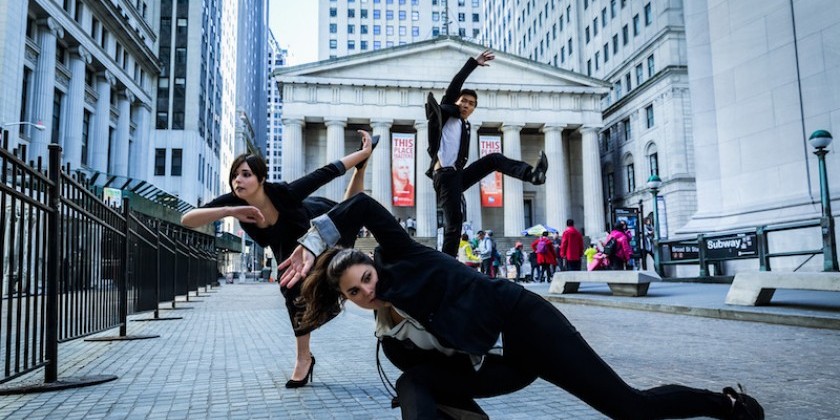Germaul Barnes and Monstah Black's Contemporary Improvisation for Black Men, A Much Needed Safe Space

This afternoon I was slammed into a wall by a police officer. As I called out, “I beg your pardon!” he pulled back, looked me over, and grumbled that I looked like a suspect before running off.
It was shocking. Only afterward did I realize that I was not afraid. I was angry, which is dangerous because of this being-shot-while-black nonsense. In my mind, I am a ballet teacher, a black male Mary Poppins even, but to that police officer, I was just another black guy, a threat to be put down.
Collecting myself, I flashbacked to the last time I felt safe: at the Contemporary Improvisation for Black Men. Hosted once a month by Germaul Barnes and Monstah Black, CIBM invites those who identify as black and male to explore moving without fear of judgement.
The workshop begins with each participant introducing himself. My introduction bursts forth with clipped rage. “My name is Juan Michael Porter II. I am well-spoken, cultured, poised, and the only black man ever in the room. My articulation is treated like a party trick: ‘Look at the black boy pretending to be white.’ Should I grunt and smash people instead?”
I stop. I never speak those thoughts aloud. “Let it out. I hear you brother,” someone says. Despite my embarrassment, I unleash my loathing for white women who look at me as if I might steal their tacky clutches, when the reality is that they might steal something much more precious from me. Every man who speaks shares a burden I recognize. I don’t cry, but I want to.
Our dancing starts with a few simple prompts: watch, react, and engage. This could be any movement workshop in the city. What makes it refreshing is the lack of artifice or competition. No one is trying to outdo anyone else or draw attention to himself. Too often, men — especially black men — are encouraged to dominate one another. Here, the overarching principle is appreciation, allowing each man to discover new means of engagement while communicating honestly, on his own terms.
One guy in the room lacks advanced dance training. A few hesitant shuffles and stretches are all he can muster. Watching us interact makes him smile, like he didn’t know that men are allowed to move this way. He closes his eyes, bends forward, and springs skyward like an uncoiled jack-in-the-box. His head rolls from side to side, nearly knocking him over; rather than remain upright, he falls into a deep lunge that rebounds into gentle, zig-zagging chugs. He looks like Gene Kelly doing Fosse steps. Out of steam, he nearly stops until another dancer approaches with a game of trading steps.

We come together to share our impressions. This untrained dancer says how free he felt even though “he had no idea what he was doing.” The permission to move unlocked an undiscovered form of expression within him.
The next exercise combines gestures and words around the accomplishments of a celebrated historical black figure. Word Flow, Germaul calls it. I tap into an unconscious rage. I am rarely around other black men. My resentment at their easy camaraderie is fading because I recognize that “the brotherhood” is open to me too. My flow excavates how hurt I feel from constant marginalization.
Other flows include Ralph Ellison motivated references to attire creating discrimination, a joyful riff on living life to the fullest in the spirit of Duke Ellington, and a challenge inspired by Langston Hughes that building walls will promote peace. The irony of this final flow, "why erect barriers?", is not lost on me.
“Safe spaces are ideological constructs that exclude others,” is what I thought when this workshop began. Obviously things are not that simple; the fellowship established with other black men reminds me that nothing is wrong with me. I am a black man, and that is just great. Maybe there is nothing innovative about this workshop other than it wants me to celebrate that through dance.
Our final improv links us in a long line that curls in on itself to create a nurturing embrace. That hug is with me even as I return to myself on the streets of Union Square, freshly accosted by a police officer. My ears are ringing, but I will be okay because I have this promise from a bunch of black men that they will be there to dance it out with me whenever I need. I need it now.
CIBM returns in January 2018. If you identify as Black and Male, I suggest participating in this healing experience. Until safe spaces become redundant, I am thankful that this option exists. For more information about CIBM, visit: http://www.viewsicdance.com/contemporary-improvisation-black-men/
The Dance Enthusiast Hits The Streets to see what is happening in our dance world, and Create Conversation.
For more Dance Enthusiast Day in the Life pieces, which connect audiences to the behind-the-scenes of dance, click here.














